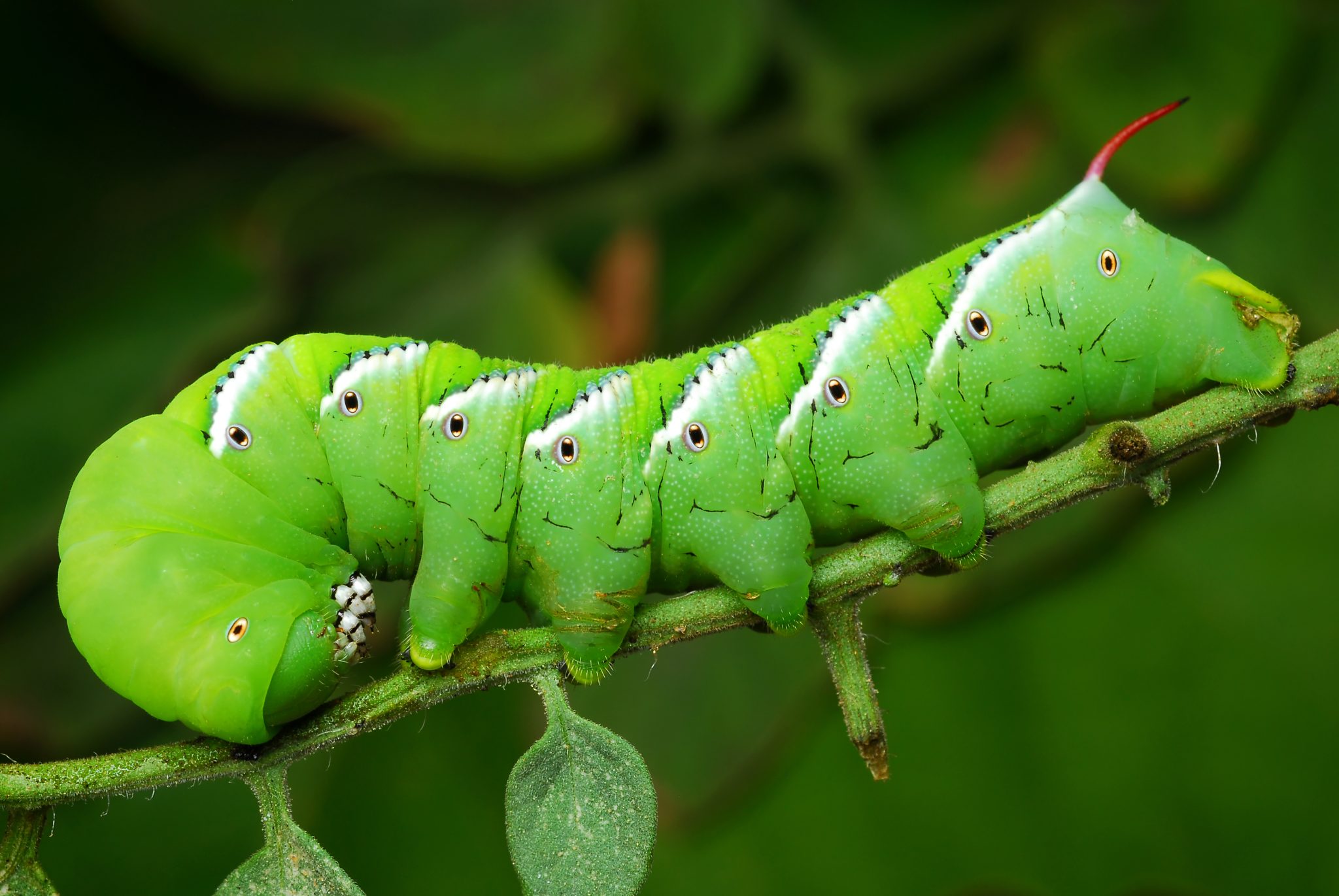Lawn & Garden

There are two species of hornworms; both are the common garden pest of Solanaceae plants. One is the tomato hornworm (Manduca quinquemaculata), and the other is the tobacco hornworm (M. sexta). They are closely related species that look similar in size and appearance and cause similar damage to the same host plants.
Identification
Hornworms are huge, beautiful caterpillars. Newly hatched young hornworms are yellow to white with no markings. As they grow and molt, their body turns green in color and develops V-shaped markings on each side and a pointy horn-like tail at the end of the body. Full-grown caterpillars can measure up to 4 inches in length. The differences between the two species are the V-shaped markings on the side of the body are yellow-white in tomato hornworms but white-black diagonal line-like in tobacco hornworms. Additionally, the pointy tail on the last body segment is black in tomato hornworms, whereas it is brown or reddish in tobacco hornworms.
Adult moths are giant and robust-bodied, with a wingspread of 4 to 5 inches. They are gray-brown and with yellow spots on the sides of the body. The tomato hornworm adult is called a 5-spotted hawk moth, whereas the tobacco hornworm adult is called the Carolina sphinx moth.
Life cycle
Hornworms overwinter as pupae and emerge as adult moths in spring. After mating, female moths lay single, oval-shaped light green eggs on the undersides of plant leaves. Caterpillars hatch, begin to feed the leaves, and are full-grown in 3 to 4 weeks. Mature caterpillars drop off of plants and burrow into the soil to transform into pupae. Moths emerge in about two weeks to begin the second generation during mid-summer. Caterpillars feed until late summer or early fall before pupating in the soil for winter.
Hosts
Their favorite plant is the tomato, but they have also been found on pepper, eggplant, and potato plants. Additionally, many weeds can serve as alternate hosts, including horsenettle, jimsonweed, and nightshade. Adult moths feed on the nectar of various flowers.
Damage
Hornworm caterpillars feed on plant leaves and do not usually move far from the original site of oviposition unless they have entirely defoliated the plants. They can also chew holes in green developing fruit.
Why don’t I notice them until the caterpillars are very large and plant damage is done?
They are well camouflaged among the leaves of their host plants. Young caterpillars are small and hardly visible. Caterpillars, young and mature, also blend in with the leaves very well and may go unnoticed until most of the damage is done. However, as they feed, they create dark green or black droppings that are clearly visible.
Controlling Hornworms
- Remove weeds to reduce the number of sites where the moths can lay eggs.
- Till the soil after harvest to destroy burrowing caterpillars and pupae.
- Physical removal (pick them off the infested plant) is usually the only necessary management.
Natural enemies can help manage hornworms.
- Natural enemies include general predatory insects such as lady beetles, green lacewings (prey upon eggs and young caterpillars), and paper wasps.
- Natural enemies also include parasitoids such as the braconid wasp. The wasp lays eggs on the hornworms; eggs hatch into wasp larvae that feed inside the caterpillar and form white rice-like cocoons protruding from the caterpillars’ body (it looks like the body is covered by white rice-like cocoons because there are so many of the cocoons). If you see this happening, leave the hornworms in the garden to allow the adult wasps to emerge. At this stage, the parasitized caterpillars lose the ability to eat and will die after the wasps emerge. The wasp will look for other hornworms to parasitize. (With full-grown caterpillars that have not shown the cocoons, gardeners can pick them up, position them in a net bag, and wait for the cocoons to appear and wasps to fly out. This saves them as a parasitoid reservoir.)
Pesticides are generally not necessary. But, if other options are not effective or practical, you may consider applying a product to kill smaller worms before severe defoliation. The choice of insecticide is the EPA-approved natural product Spinosad or insecticidal soap, rather than using residual insecticide in home gardens.

